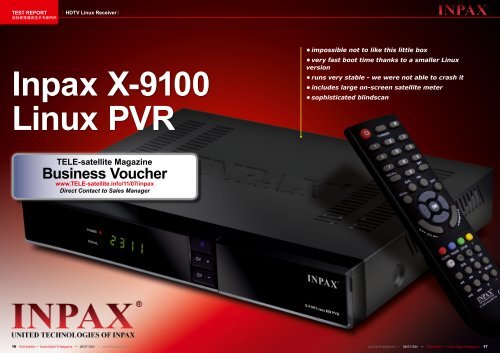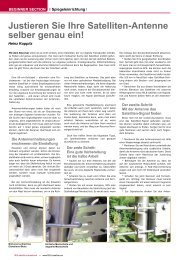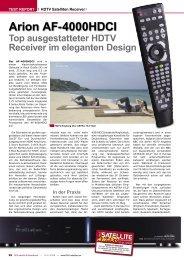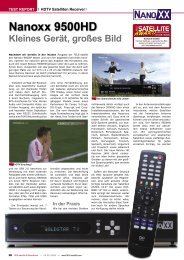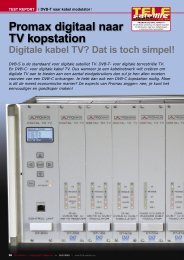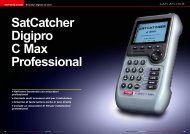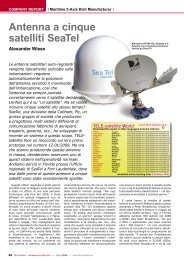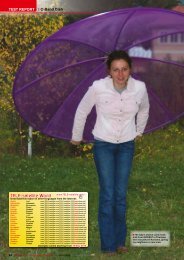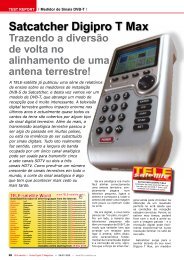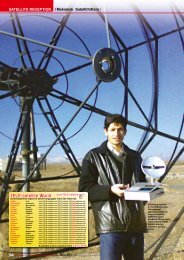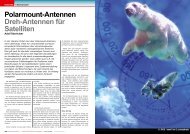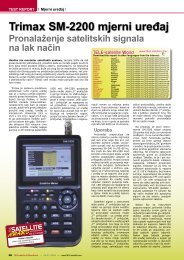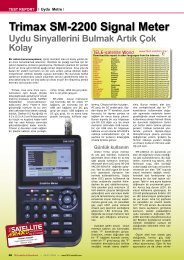Inpax X-9100 Linux PVR - TELE-satellite International Magazine
Inpax X-9100 Linux PVR - TELE-satellite International Magazine
Inpax X-9100 Linux PVR - TELE-satellite International Magazine
You also want an ePaper? Increase the reach of your titles
YUMPU automatically turns print PDFs into web optimized ePapers that Google loves.
TEST REPORT<br />
该独家报道由技术专家所作<br />
HDTV <strong>Linux</strong> Receiver<br />
<strong>Inpax</strong> X-<strong>9100</strong><br />
<strong>Linux</strong> <strong>PVR</strong><br />
<strong>TELE</strong>-<strong>satellite</strong> <strong>Magazine</strong><br />
Business Voucher<br />
www.<strong>TELE</strong>-<strong>satellite</strong>.info/11/07/inpax<br />
Direct Contact to Sales Manager<br />
• impossible not to like this little box<br />
• very fast boot time thanks to a smaller <strong>Linux</strong><br />
version<br />
• runs very stable - we were not able to crash it<br />
• includes large on-screen <strong>satellite</strong> meter<br />
• sophisticated blindscan<br />
16 <strong>TELE</strong>-<strong>satellite</strong> — Global Digital TV <strong>Magazine</strong> — 06-07/2011 — www.<strong>TELE</strong>-<strong>satellite</strong>.com www.<strong>TELE</strong>-<strong>satellite</strong>.com — 06-07/2011 — <strong>TELE</strong>-<strong>satellite</strong> — Global Digital TV <strong>Magazine</strong> 17
TEST REPORT<br />
0.52<br />
HDTV <strong>Linux</strong> Receiver<br />
Turkish Delight<br />
A high-definition <strong>Linux</strong>-based<br />
<strong>PVR</strong> promising a number of<br />
interesting features, all housed in<br />
a tiny case. Can it be possible?<br />
Hailing from Istanbul, Turkey,<br />
the X-<strong>9100</strong> <strong>PVR</strong> from<br />
INPAX is quite a surprise.<br />
The little black box measures<br />
just 26cm across,<br />
19cm deep and 4cm high<br />
and comes in a stylish shiny<br />
black case with a minimalist<br />
appearance. There are just<br />
three buttons on the front<br />
panel: Standby, channel up<br />
and channel down. An LED<br />
display displays the current<br />
channel number, or the<br />
clock in standby.<br />
A flap on the right-hand<br />
side conceals a USB port<br />
and a single smart card slot<br />
which seems to be able to<br />
read a variety of cards – it<br />
even accepted my Sky Digital<br />
card and allowed me to<br />
view all my subscription<br />
channels except those that<br />
are tied to an individual<br />
receiver. This was quite a<br />
surprise. The card slot is<br />
the only conditional access<br />
option: there is nowhere to<br />
add a CAM.<br />
At the back, the antenna<br />
input and loop-through<br />
serve the single tuner. Video<br />
options are limited to HDMI,<br />
Scart or composite video,<br />
whilst there are stereo audio<br />
outputs plus S/PDIF. For<br />
connection to the outside<br />
world there’s an Ethernet<br />
LAN port and an RS232 port.<br />
A cold start of the receiver<br />
doesn’t take as long<br />
as might be expected from<br />
a <strong>Linux</strong>-based receiver, taking<br />
around 45 seconds from<br />
flicking the switch for a picture<br />
to appear on screen.<br />
This is one of the surprises<br />
that come from the X-<strong>9100</strong><br />
utilising a much smaller,<br />
embedded version of <strong>Linux</strong><br />
than the more complex versions<br />
we’ve seen in the past.<br />
Those who might be<br />
daunted at the prospect of<br />
setting up a <strong>Linux</strong> receiver<br />
need not worry too much.<br />
The options and menu system<br />
are no more complicated<br />
than those of a standard<br />
receiver. USALS is supported<br />
to enable easy setup of<br />
a DiSEqC motor, with the<br />
added bonus of some major<br />
cities already being programmed<br />
into the receiver’s<br />
memory.<br />
A wide range of LNB settings<br />
are included, and<br />
as the receiver is of Turkish<br />
origin, special settings<br />
for DIGITURK are even included.<br />
If none of them suit<br />
your system the LNB’s frequencies<br />
can also be<br />
specified manually.<br />
DiSEqC is<br />
supported from<br />
version 1.0 to<br />
1.3 to ensure<br />
that just about<br />
any motor or<br />
switching setup<br />
will be supported.<br />
71 <strong>satellite</strong>s<br />
from around<br />
18 <strong>TELE</strong>-<strong>satellite</strong> — Global Digital TV <strong>Magazine</strong> — 06-07/2011 — www.<strong>TELE</strong>-<strong>satellite</strong>.com www.<strong>TELE</strong>-<strong>satellite</strong>.com — 06-07/2011 — <strong>TELE</strong>-<strong>satellite</strong> — Global Digital TV <strong>Magazine</strong> 19<br />
06-07/2011<br />
<strong>Inpax</strong> X-<strong>9100</strong> <strong>Linux</strong> <strong>PVR</strong><br />
A competent good-looking black box with<br />
full range of functions<br />
the planet are pre-programmed<br />
into the receiver<br />
and these can be edited and<br />
deleted as required. New<br />
<strong>satellite</strong>s can be added as<br />
required by simply specifying<br />
the orbital position. If<br />
you are setting your own<br />
dish up, you’ll be pleased to<br />
see the inclusion of a large<br />
on-screen signal meter<br />
function to help you find a<br />
good signal.<br />
Scanning <strong>satellite</strong>s is fast<br />
compared to some other<br />
<strong>Linux</strong>-based receivers. For<br />
viewers of Canal Digitaal, TV<br />
Vlaanderen or UPC Direct on<br />
ASTRA 1, a special fast scan<br />
function is available. For<br />
the rest of us, a standard<br />
scan zips across the <strong>satellite</strong><br />
spectrum in good time.<br />
A scan across Astra 2 took<br />
four minutes to scan the 90<br />
stored frequencies.<br />
A very welcome addition is<br />
a blind scan option, so that<br />
any frequencies not already<br />
held in the transponder list<br />
can be found. This works a<br />
little differently than others<br />
we’ve seen in the past. First,<br />
the entire frequency spectrum<br />
is scanned, adding any<br />
newly-found frequencies to<br />
the stored transponder list.<br />
After this, the regular scan<br />
kicks in, scanning the new<br />
frequencies alongside those<br />
previously stored. This adds<br />
some time to the scanning<br />
process, 2,5 minutes were<br />
taken to find and add an<br />
extra eight transponders to<br />
the list, then another 4:15<br />
to scan them all. The blind<br />
scan isn’t ideal for feedhunting<br />
however, as there is<br />
no ability to scan a portion<br />
of the frequency band.<br />
Channels are accessed<br />
from a channel list similar to<br />
those on most other receivers.<br />
The left and right buttons<br />
are used to filter the list<br />
between FTA-only, HD and<br />
encrypted channels, plus of<br />
course there is the option to<br />
display everything. The red<br />
button can be used to filter<br />
the list further by limiting<br />
the <strong>satellite</strong>s shown in the<br />
list. An A-Z function is also<br />
available, which filters the<br />
list by the first letter of the<br />
channel name, but doesn’t<br />
sort it further than this – so<br />
Azerbaijan TV would still appear<br />
ahead of Aastha TV if<br />
this was their order in the<br />
default list – this I found just<br />
a little confusing. Dedicated<br />
page up and down buttons<br />
on the remote help to speed<br />
navigation of this and other<br />
lists around the menus.<br />
The remote itself is a<br />
standard, generic feeling<br />
model, not helped by the<br />
occasional occurrence of the<br />
pressed button repeating<br />
your previous action rather<br />
than the one you were expecting.<br />
Another rather<br />
strange quirk is that the order<br />
of the coloured function<br />
buttons is different from the<br />
normal red-green-yellowblue<br />
sequence. I didn’t even<br />
know that this order has<br />
been burned into my brain<br />
from the use and testing<br />
of so many receivers over<br />
the years, but I proved that<br />
it is by pressing blue when<br />
I thought I was pressing<br />
green several times.<br />
The remote is kept simple,<br />
and there are no buttons<br />
for selecting the correct aspect<br />
ratio, or screen resolution,<br />
but these options<br />
can be found inside the receiver’s<br />
settings menus.<br />
Most important options are<br />
found here, including to select<br />
between RGB or CVBS<br />
from the Scart port. To access<br />
the latter option select<br />
HDMI mode 5761 and push<br />
volume buttons up or down<br />
to toggle between RGB and<br />
CVBS.<br />
There is one special feature<br />
in the menus where<br />
<strong>Inpax</strong> must however be congratulated.<br />
An option exists<br />
to store the sound volume<br />
setting for each channel individually.<br />
This is the perfect<br />
answer to that all-too-common<br />
situation of changing<br />
channel from an overly quiet<br />
one to one of those that has<br />
the sound cranked up so loud<br />
that your neighbours will be<br />
banging on the wall within<br />
no time. Of course, if only<br />
audio levels could be regulated<br />
to avoid this situation,<br />
such a function wouldn’t be<br />
needed. But that is unlikely<br />
to happen anytime soon and<br />
very likely never, so in the<br />
meantime: thank you <strong>Inpax</strong><br />
for thinking of this.<br />
The channel editing functions<br />
are limited to deletion,<br />
moving, and renaming. The<br />
sometimes important ability<br />
to edit PIDs is missing,<br />
for example. There are eight<br />
preset favourites lists. Their<br />
names are quite strange,<br />
with the first few letters<br />
missing. But it’s easy to correct<br />
this by simply adding<br />
a new favorite and giving it<br />
whatever name you want.<br />
The yellow button in the FAV<br />
menue will create a new favorite<br />
list.<br />
There is no room inside the<br />
tiny case for a hard drive,<br />
recordings have to be made<br />
onto a USB device plugged<br />
into the front socket. Recordings<br />
can be started directly<br />
from the remote’s record<br />
button or from a timer event<br />
that can be set manually or<br />
from the EPG. The <strong>9100</strong>’s<br />
EPG is quite usable, and
1<br />
2<br />
3<br />
4<br />
5<br />
20 <strong>TELE</strong>-<strong>satellite</strong> — Global Digital TV <strong>Magazine</strong> — 06-07/2011 — www.<strong>TELE</strong>-<strong>satellite</strong>.com<br />
can be switched between a<br />
one and seven-day version.<br />
It’s a bit strange though in<br />
that the grid display only fills<br />
a quarter of the screen, so<br />
it’s not the easiest to quickly<br />
see what is scheduled more<br />
than an hour or two into the<br />
future.<br />
The event timer is also of<br />
a standard type, with some<br />
repeating options including<br />
Monday to Friday and weekends<br />
only. The receiver can<br />
be set to either record or<br />
just switch to the selected<br />
1. Blind scan<br />
2. Channel list<br />
3. EPG<br />
4. Favourites editing<br />
5. File browser<br />
6. FTP client<br />
7. Multi picture-in-picture<br />
8. Recorded programme<br />
playback<br />
channel at the desired time,<br />
and there’s also a choice<br />
to switch off after the recording<br />
has finished. While<br />
a recording is in progress,<br />
the channel list is restricted<br />
only to channels on the<br />
transponder being received<br />
so there’s no chance of lost<br />
recordings or receiver meltdown.<br />
It’s worth noting at this<br />
point that the manual warns<br />
that while the theoretical<br />
hard drive size limit is four<br />
partitions totalling 2 terabytes<br />
(which I think even I<br />
may have trouble filling up),<br />
it is not recommended to<br />
use partitions greater than<br />
120 gigabytes.<br />
Recording and playback<br />
works very well, with no<br />
6<br />
7<br />
8
problems noted – even<br />
when recording HD channels<br />
to a USB stick. My experience<br />
with <strong>Linux</strong> receivers<br />
has been mixed in the past.<br />
I remember too well some<br />
important timer recordings<br />
that never even started<br />
because the receiver had<br />
crashed hours earlier, still<br />
displaying its equivalent of<br />
the Windows hourglass and<br />
a frozen picture of the lastreceived<br />
channel. Despite<br />
my best efforts to confuse<br />
and confound the little box,<br />
I wasn’t able to crash it at<br />
all, even when recording.<br />
As recordings are stored<br />
on a USB device, it’s easy to<br />
access them on a PC. Another<br />
“well done” goes to <strong>Inpax</strong><br />
here – the settings menu<br />
gives a choice of recording<br />
format between .MPG and<br />
.TS files, a welcome extra<br />
choice that could be very<br />
useful to those who wish to<br />
edit or archive their recordings<br />
onto DVD or convert<br />
them into other formats.<br />
Despite the ease of connection<br />
to the outside world<br />
via Ethernet, it isn’t possible<br />
to access recordings by<br />
FTP, so disconnecting the<br />
USB device and walking it to<br />
a computer is the only way<br />
to access them. There is an<br />
FTP client available, but this<br />
works in one direction only<br />
to copy media to the USB<br />
for playback. It is also possible<br />
to connect to an SMB<br />
(Samba) share in the same<br />
one-way manner.<br />
The variety of file formats<br />
that can be replayed<br />
is impressive, and most<br />
of the sample files I tried<br />
played without any trouble.<br />
The list includes AVI, MPG,<br />
VOB, FLV, MP4, MKB, 3GP<br />
and ASF which covers most<br />
bases. It’s nice to see that<br />
channel lists saved in the<br />
SatcoDX .SDX format may<br />
also be imported from the<br />
file menu.<br />
9<br />
9. The embedded <strong>Linux</strong>’s web<br />
interface<br />
10. Satellite scan<br />
11. Signal meter<br />
12. Telnet into the receiver<br />
10<br />
11<br />
Also included is an internet<br />
radio player. When it<br />
works, it is really quite good<br />
and kept a connection from<br />
my location in England to an<br />
Australian channel overnight<br />
without any problems. I did<br />
get several “server busy”<br />
messages, but when I did<br />
12<br />
get through I received some<br />
good quality audio, with<br />
some stations accompanied<br />
by artist names and song<br />
titles. Scrolling through the<br />
huge station lists is a real<br />
pain though as each page of<br />
the list is retrieved from the<br />
internet when requested.<br />
After a long time in the<br />
alphabetical list I gave up<br />
while still on the letter A,<br />
but at least there’s a favourites<br />
list here too. This will<br />
be invaluable when I want<br />
to return to the esoteric<br />
mix of stations I have already<br />
found, from 247 Polka<br />
Heaven (“The World’s Polka<br />
Network”) to Amateur Repeater<br />
W6NUT. I wonder if<br />
even the radio hams in California<br />
would imagine they<br />
22 <strong>TELE</strong>-<strong>satellite</strong> — Global Digital TV <strong>Magazine</strong> — 06-07/2011 — www.<strong>TELE</strong>-<strong>satellite</strong>.com<br />
were being overheard on a<br />
<strong>satellite</strong> receiver across the<br />
world via the internet? And<br />
will I ever get to the end of<br />
the list, to find out if New<br />
York’s Z100 is available?<br />
Dragging myself away<br />
from the hypnotic rhythm of<br />
the polka to the next menu<br />
entry brings us a Youtube<br />
player. This also works very<br />
well, and where the video<br />
quality is good enough, is<br />
perfectly watchable on a TV.<br />
A number of presets give<br />
access to the most popular<br />
videos of the moment<br />
plus comedy, music, news,<br />
sports and so on. A search<br />
is also available which opens<br />
up the entire weird and wild
world of Youtube onto your<br />
TV. It is a nice addition to<br />
have and the video plays<br />
back a lot smoother than<br />
it does on my ageing overloaded<br />
PC.<br />
The final menu entry in<br />
the set of internet applications<br />
is not mentioned in the<br />
manual: “Extra Movies”. I’m<br />
sure most of us would say<br />
“yes please” to some extra<br />
movies, but this menu is<br />
password protected; here<br />
we explain to all of you how<br />
to access it:<br />
Enter IP settings in setup<br />
menue, press green button<br />
which closes DHCP and instead<br />
asks for DNS1. Enter<br />
208.67.222.222 and save by<br />
pushing red button. Then<br />
DNS2 pops up, enter same<br />
IP 208.67.222.222 again and<br />
save with red button. Now<br />
the receiver needs to be restarted<br />
by switching power<br />
off and on. Go again to “Extra<br />
Movies” and now type in<br />
9-8-7-6 for password. Voila,<br />
it works.<br />
It’s possible to use telnet<br />
to get into the receiver,<br />
and this reveals a command<br />
prompt from the BusyBox<br />
system, as utilised by the<br />
Amazon Kindle and many<br />
other devices. BusyBox gives<br />
access to some basic <strong>Linux</strong><br />
commands, which on their<br />
own are probably of little or<br />
no use to the everyday user<br />
but we can at least be nosy<br />
and see what is contained on<br />
the internal memory. Similarly,<br />
connecting with a web<br />
browser gives an interface<br />
to the embedded <strong>Linux</strong> operating<br />
system with plenty<br />
of debugging information.<br />
There’s not really anything<br />
of use there either, but <strong>Linux</strong><br />
fans could find the information<br />
interesting. Whether<br />
or not it may be possible to<br />
add to the software inside<br />
the machine to enable more<br />
functionality is not clear and<br />
there are no clues from the<br />
receiver or its manual.<br />
The X-<strong>9100</strong> is a different<br />
<strong>Linux</strong>-based receiver than<br />
most we’ve seen in the past.<br />
For some, this could be a<br />
disappointment as it feels<br />
more like a conventional<br />
receiver in use than those<br />
running larger <strong>Linux</strong> distributions<br />
such as Enigma2.<br />
This however makes it more<br />
appealing to those who want<br />
to watch TV with less hassle<br />
or the threat of things<br />
not working as smoothly as<br />
they could. Connecting to<br />
the internet is as easy as<br />
plugging in an Ethernet cable<br />
if you have DHCP available<br />
on your router, and the<br />
bonus additions of the Youtube<br />
and internet radio players<br />
are genuinely useful. If<br />
the internet radio interface<br />
could be made a little better<br />
it would on its own be a<br />
perfect, easy way to access<br />
thousands of stations in<br />
good quality.<br />
What is most pleasing<br />
though is the receiver’s re-<br />
liability. My fear of losing<br />
recordings from previous<br />
<strong>Linux</strong> receiver experiences<br />
is almost gone. Whilst testing<br />
the receiver for this review<br />
it has not let me down<br />
at all, and that is what most<br />
people want and need: a receiver<br />
that does all it says<br />
it will, and doesn’t crash<br />
at the most important moments.<br />
There are a few<br />
small quirks and criticisms<br />
as I have mentioned already,<br />
most of which may<br />
be addressed in future software<br />
updates. It’s impossible<br />
not to like this little<br />
black box and be impressed<br />
by the full range of functions<br />
it contains. Overall<br />
+<br />
Audio settings can be stored for each channel<br />
individuall.y<br />
Accepts very large harddrives via USB.<br />
Software runs extremely stable.<br />
<strong>PVR</strong> allows storing in .TS format.<br />
Impressive list of file formats for playback.<br />
-<br />
Alphabetical channel listing only sorts by first letter.<br />
Color coding of remote not to standard.<br />
this is a competent, goodlooking<br />
little machine that<br />
does its job very well.<br />
Now, you must excuse<br />
me – it is time to wrap up<br />
this report so that I can<br />
watch some more funny ani-<br />
Expert Opinion<br />
Andy Middleton<br />
<strong>TELE</strong>-<strong>satellite</strong><br />
Test Center<br />
UK<br />
mals on Youtube, listen to<br />
some more polka, and, oh!<br />
I almost forgot that I could<br />
even find some time away<br />
from these distractions to<br />
watch some good old-fashioned<br />
HD TV on my new little<br />
friend too!<br />
TECHNICAL<br />
DATA<br />
Distributor İNPA ELEKTRONİK SAN. VE TİC.LTD.ŞTİ.<br />
Kemeraltı Str. Şefkat Business No: 1-3 Floor:4<br />
Karaköy, Istanbul, Turkey<br />
Tel. +90 212 293 63 12 | +90 212 293 63 13<br />
Fax +90 212 293 63 18<br />
Website http://www.inpax.com<br />
Email info@inpax.com.tr / inpax@inpax.com.tr<br />
Model X-<strong>9100</strong> <strong>Linux</strong> HD <strong>PVR</strong><br />
Function HDTV Satellite Receiver with <strong>PVR</strong><br />
SCPC compatible Yes<br />
USALS Yes<br />
DiSEqC 1.0/1.1/1.2/1.3<br />
Scart connectors 1<br />
Symbol rates QPSK – 2000 to 45000<br />
QPSK – 2000 to 45000<br />
8PSK – 2000 to 45000<br />
MPEG modes MPEG-1, MPEG-2, MPEG-4, H.264, MP@ML<br />
Audio outputs 2 (left & right)<br />
Video outputs Composite, HDMI<br />
Resolutions 480p, 480i, 576p, 576i. 720p, 1080i at 50Hz,<br />
720p &1080i at 60Hz, 1080p at 30Hz<br />
UHF output No<br />
0/12 volt output No<br />
Digital audio output S/PDIF<br />
EPG Yes<br />
C/Ku-band compatible Yes<br />
Power supply 100-240V AC, 50/60Hz<br />
Common interface 2 None<br />
Card slots 1 universal<br />
ENERGY<br />
DIAGRAM<br />
Apparent Power<br />
Active Power<br />
Mode Apparent Active Factor<br />
Active 19 W 10 W 0.52<br />
StandBy 14 W 7 W 0.5<br />
24 <strong>TELE</strong>-<strong>satellite</strong> — Global Digital TV <strong>Magazine</strong> — 06-07/2011 — www.<strong>TELE</strong>-<strong>satellite</strong>.com<br />
www.<strong>TELE</strong>-<strong>satellite</strong>.com — 06-07/2011 — <strong>TELE</strong>-<strong>satellite</strong> — Global Digital TV <strong>Magazine</strong><br />
25


